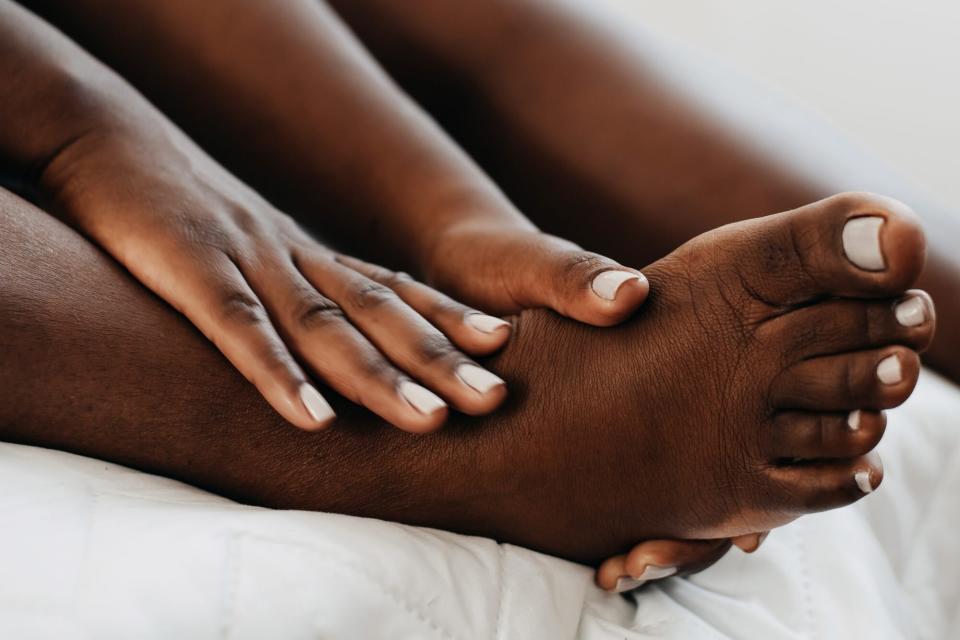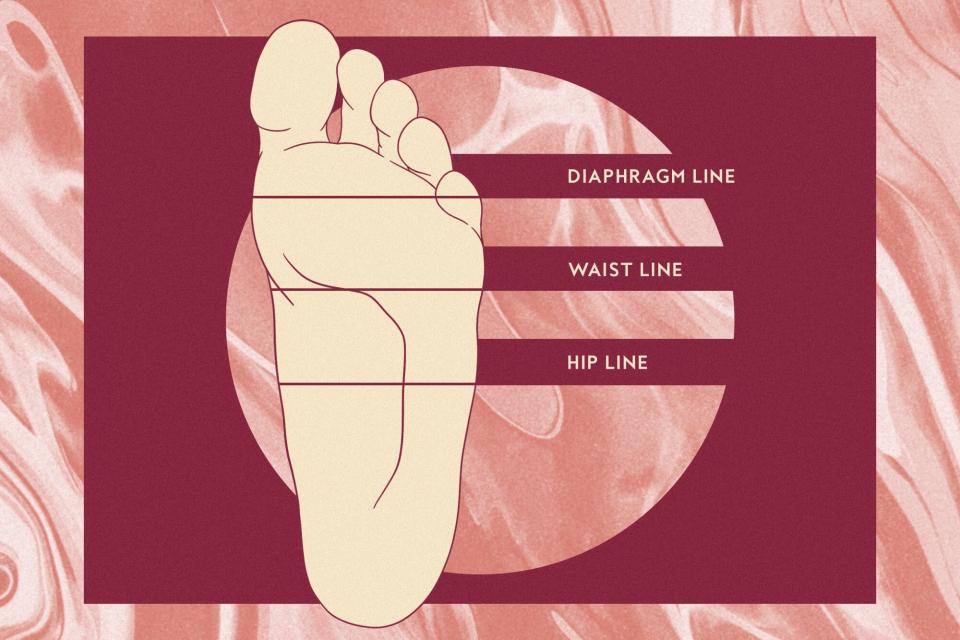How to Use Foot Reflexology for Stress and Anxiety

Getty Images
If you're like me and have tried just about everything to ease stress and anxiety over the past two years, it might be time to get your feet involved.
Believe it or not, certain points on your feet target different areas of your body to relieve pain and sore muscles and even help with chronic health conditions ranging from headaches to yes, anxiety. It may sound a little out-there, but it's called foot reflexology, it's been around forever, and yes, it feels amazing.
RELATED: I Wore Ear Seeds for Five Days and My Chronic Anxiety Disappeared
We tapped the experts to find out what a foot reflexology session actually entails and how the massage-like service can help ease stress and boost your mental health, too.
Video: Can Getting a Daith Piercing Really Help Migraine Symptoms?
What Is Foot Reflexology?
Reflexology is a form of Traditional Chinese Medicine (TCM) believed to date back some 3,000 years, according to licensed acupuncturist and founder of CBD and Chinese Herbs medicine retailer Dragon Hemp, Kevin Menard.
Similar to acupuncture, reflexology targets pressure points that are assigned to different areas in your body, addressing and preventing any issues throughout the body — like sore muscles and chronic illnesses — sans needles. Like other TCM practices, reflexology is all about returning balance to your body's flow of energy, also known as Qi.
"Reflexology restores the natural flow of Qi through the intentional massaging of the feet, hands and ears," explains Menard. "It is believed that [these body parts] are a microcosm of the entire human body, and that a skilled reflexologist can detect imbalances of Qi and disease in specific organs." Menard adds that varying degrees of pressure can send the Qi and blood to the corresponding organs to restore balance and improve the health of your body.
According to Leticia Gilmore, President of the American Reflexology Certification Board (ARCB), your entire body is mapped out on your feet, hands, and ears. So, while reflexology, in general, can be performed using numerous extremities, foot reflexology focuses solely (pun intended) on your feet.
RELATED: I Tried Acupuncture to Move On From a Breakup — And It Actually Worked
How Does Foot Reflexology Work?
The process involves using thumb and finger techniques to apply alternating pressure to reflexes in order to trigger the 7,000-plus nerve endings in each foot and send impulses throughout the body, says Gilmore. "Reflexology addresses every organ, gland, and system in the body," she adds. "It is a method for promoting health by activating the healing potential of the body through relaxation."
Gilmore adds that when you're receiving the treatment, the reflexologist will first work through all the points, addressing your entire body before spending some time on the specific areas of concern. (For example, "if a new client is having a gastric condition, we will first work all reflexology points for the whole body, only then would we return to focus on the points related to the digestive system," says Gilmore.) This is mostly because it can be tricky to exactly pinpoint where the issue is stemming from.
But foot reflexology also isn't just about treating already existing problems — it can also be preventative and beneficial even if you're perfectly healthy, says Gilmore, adding that symptoms like headaches, fertility concerns, and sore muscles can all be treated through reflexology.
Reflexologists reference a foot map that is typically divided into three zones the "Diaphragm Line," the "Waist Line," and the "Hip Line," with each section pertaining to that part of the body, and generally, each foot is responsible for its respective side of the body. Gilmore says the top of your foot represents your head and the heel acts as the bottom of your torso.
The map below is a simplified breakdown of the foot, but there are many more specific points that correlate with each organ and body part. You can find a comprehensive map on the International Institute of Reflexology website.

Kaitlyn Collins/InStyle
How Does Foot Reflexology Treat Stress and Anxiety?
In addition to treating sinus troubles, digestive issues, and more, reflexology can be a great way to combat anxiety and stress, says Gilmore. When we're experiencing great levels of stress, we tend to tighten our muscles, but reflexology can help to relax that tension that you're harboring. In fact, a 2020 study from Evidence Based Complement Alternate Medicine found that in 26 randomized controlled studies involving 2,366 participants, foot reflexology significantly improved adult anxiety.
Reflexology can bring a sense of peace and connection to your body by "shifting the brain wave patterns into deeper consciousness where the body can most effctively heal itself." —lisa hensell, founder of Seattle reflexology
So why is the practice so effective in reducing these mental health conditions? Well, according to Lisa Hensell founder of Seattle Reflexology, the practice releases endorphins and serotonin which help the body to shift from a sympathetic state (your flight or fight response) into a parasympathetic mode (your resting state). Reflexology can bring a sense of peace and connection to your body "by shifting the brain wave patterns into deeper consciousness where the body can most effectively heal itself," Hensell explains.
Mental health experts, like New York City-based neuropsychologist and director of Comprehend the Mind Sanam Hafeez, Psy.D, agree that reflexology can be a powerful tool for relieving stress and anxiety, in addition to therapy and other methods of treatment. Dr. Hafeez says that reflexology can reduce stress and anxiety by "rebalancing the lymphatic and endocrine system, and boosting circulation, inducing a state of calm throughout your body and mind, leaving you feeling less stressed and anxious."
After consistent practice, you can apply the release from reflexology in your everyday life. "We know what stress feels like. What we forget is what true relaxation feels like," says Gilmore. "Regular reflexology sessions create a familiarity with what true relaxation feels like. This familiarity gives us a baseline sensation that we can return to more rapidly in times of stress."
"Regular reflexology sessions create a familiarity with what true relaxation feels like. This familiarity gives us a baseline sensation that we can return to more rapidly in times of stress." —Leticia Gilmore, president of the American Reflexology Certification Board (ARCB)
Are There Any Risks Associated With Foot Reflexology?
Foot reflexology is a holistic approach that is not painful, has zero side effects, and is non-invasive, making it safe for all ages. During the session, you'll be asked to remove footwear but will otherwise remain clothed.
Gilmore says while there are very few risks associated with the practice there are exceptions, like if you currently have any broken bones. Just like any procedure or service, she stresses the importance of consulting your doctor prior to a service and considering any potential risks specific to you. She also warns against any reflexologist who claims they can "cure" your problems.
"We work with clients, not patients, and we work within our scope of practice. Should you find yourself with a reflexologist who claims they can 'cure' anything, run away," Gilmore advises.
The Bottom Line On Foot Reflexology
If you're someone who has been intrigued by TCM and acupuncture but prefers something non-invasive, reflexology could be for you. At the very least, you'll receive a relaxing, massage-like service, bound to reduce stress even if just momentarily. With very few risks and no side effects, you literally have nothing to lose — except your anxiety.

